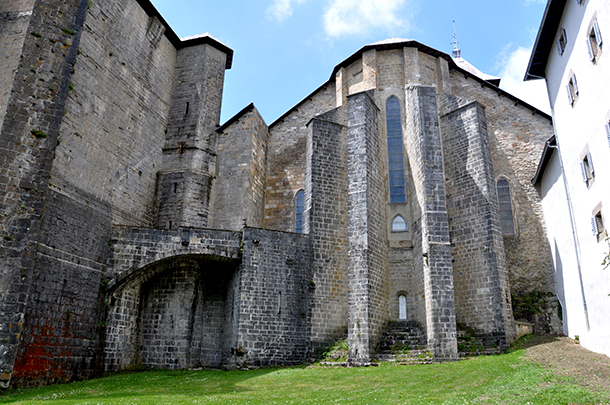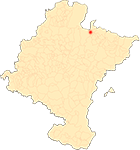Roncesvalles
Introduction
The monumental complex of Santa María de Roncesvalles, located at the foot of one of the most important passes of the Pyrenees, is a unique example at European level of the historical relevance of the great medieval hospitals. It reached its maximum splendor with the development of the Way of St. James, since in the so-called Ports of Cisa three of the four main Jacobean routes described in the Liber Sancti Iacobi converged. Although the existence of previous welfare buildings in Ibañeta and Burguete is known, the foundation of the institution dates back to the first half of the 12th century, at the request of the bishop of Pamplona, Sancho de Larrosa, who had the support of King Alfonso I the Battler.
Already in the second half of the 12th century there is evidence of the existence of a large hospital building, of which we can only see a long late Romanesque wall. The chapel of the Holy Spirit was then built, a unique carnarium or communal burial place that facilitated the burial of pilgrims from around 1200. At the beginning of the 13th century Sancho VII el Fuerte promoted the construction of the church, chosen by the monarch as a burial place. Little by little, new buildings completed an exceptional ensemble: the 13th century chapel of Santiago, a beautiful 14th century cloister (which collapsed under the weight of snow around 1600), the attached chapel of San Agustín, from the same century, and other canonical dependencies. The harshness of the climate and the evolution of history determined the replacement of certain buildings issue : the great hospital was rebuilt again and again, a circumstance that also affected the houses of the ecclesiastical dignitaries (prior, canons and beneficiaries) and other inhabitants of the place. The beautiful Gothic church also underwent drastic modifications in modern times, until it lost its medieval character. A well-intentioned but excessive restoration in the first half of the 20th century was followed decades later by more respectful actions that have given it the character it has today.
The Collegiate Church has a very rich movable heritage. The Gothic image of Santa Maria is a masterpiece of European sculpture of its time. The covers of the gospels and the reliquary called Charlemagne's Chess are only two singular pieces of a treasure that deserves a careful visit . Because Roncesvalles is one of the great places of Europe. Here the historical Hispanic campaign of Charlemagne merges with the literary passages of the Song of Roland, and the cult of the Queen of the Pyrenees with the secular Jacobean transit, which continues to attract pilgrims from all over the world at the beginning of the 21st century.
Dectot, X., "Yacente de Sancho VII el Fuerte", in Bango Torviso, I.G. (dir. cient.), Sancho el Mayor y sus herederos. El linaje que europeizó los reinos hispanos, Pamplona, 2006, pp. 371-373.
Fernández-Ladreda, C., Imaginería medieval mariana en Navarra, Pamplona, 1989.
Fernández-Ladreda, C. (Dir.), Martínez Álava, C., Martínez de Aguirre, J. and Lacarra Ducay, M.C., El arte gótico en Navarra, Pamplona, 2015.
Fuentes y Ponte, J., report histórica y descriptiva del santuario de Nuestra Señora de Roncesvalles, Lérida, 1880.
García Gainza, M.C., Orbe Sivatte, M. and Domeño Martínez de Morentin, A., Catalog Monumental de Navarra IV**. Merindad de Sangüesa, Pamplona, 1992.
Ibarra, J., History of Roncesvalles. Art. History. Legend, Pamplona, 1936.
Lambert, E. Roncevaux", Bulletin Hispanique, XXXVII (1935), pp. 417-436.
Martínez de Aguirre, J. (coord.), Enciclopedia del Románico en Navarra, Aguilar de Campoo, 2008, vol. III, pp. 1216-1224.
Martínez de Aguirre, J., Gil Cornet, L. and Orbe Sivatte, M., Roncesvalles. Hospital and sanctuary on the Camino de Santiago, Pamplona, 2012.
Miranda García, F. and Ramírez Vaquero, E., Roncesvalles, Pamplona, 1999.
Peris, A., "El Ritmo de Roncesvalles: estudio y edición", Cuadernos de Filología Clásica. Latin Studies, 11 (1996), pp. 171-209.
Pons Sorolla, F., "project de obras de restauración en la capilla del Sancti Spiritus de la Real Colegiata de Roncesvalles (Navarra)", Príncipe de Viana, XXXIX (1978), pp. 59-77.
Soria i Puig, A., The Road to Santiago. II. Stations and signs, Madrid, 1992.
Torres Balbás, L. La iglesia de la hospedería de Roncesvalles", Príncipe de Viana, VI (1945), pp. 371-403.
Thuile, J., L'Orfèvrerie en Languedoc du XIIe au XVIIIe siècle. Généralité de Montpellier, Montpellier, 1966.












